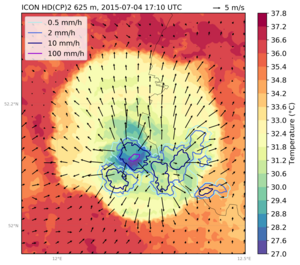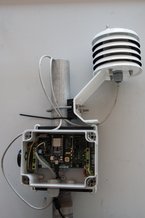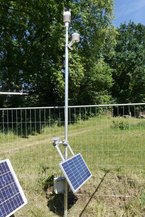Cold Pools

Cold pools are small-scale areas of evaporatively cooled downdraft air that spread on the surface underneath precipitating clouds. The passage of a cold pool front a few minutes ahead of the precipitation is generally associated with a rapid decrease in air temperature, a fast increase in air pressure and a considerable pick-up of wind speed. Since lifting at the cold pool edge often triggers new convection, they are key for understanding the organization of convective precipitation. Modern Large-Eddy simualations with grid spacing below 1 km explicitly resolve small-scale phenomena such as cold pools, however, we lack high-resolution observational data to validate these simualations.
Scientific Questions
This measurement campaign focusses on the following research questions:
- Are the simulated characteristics of cold pools (gradient strength, propagation speed, size) realistic?
- How are cold pool characteristics controlled and modified by external parameters such as rainfall intensity or structure of the atmospheric boundary layer?
Measurements


To address these questions during the FESSTVaL campaign a dense network of surface-based meteorological measurements will be set up. The backbone of the measurement strategy are 100 so-called APOLLO ("Autonomous cold POoL LOgger") stations, that record temperature and air pressure every second and are designed and built at the University of Hamburg especially for FESSTVaL. These stations will be deployed within roughly 20 km around the Meteorological Observatory Lindenberg in distances between some houndred meters and a few kilometers. The obserational network will be
complemented by about 20 compact weather sensors recording additional meteorological
variables and a high-resolution X-band rain radar.
